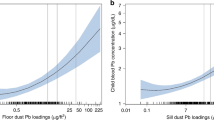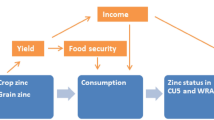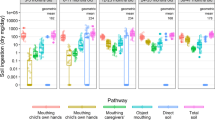Abstract
Exposure to lead, a common environmental contaminant found at hazardous waste sites, has been associated with adverse health effects to humans. Zinc, a nutritionally essential metal, may influence both the absorption and the toxicity of lead. The purpose of this study was to determine if zinc levels present in the environment affect the association between environmental lead measured in two small communities in the northeastern United States and biological measurements of lead in the residents of these communities. Soil and dust sampled in and around the homes of all participants were tested for lead and zinc. Residents aged 6 months to 14 years (n=214) provided blood samples for the determination of blood lead concentrations. Soil and dust measurements of environmental lead were positively associated with blood lead, regardless of the corresponding zinc levels in these samples. However, the magnitude of this association was 20% to 46% lower in areas with high environmental measures of zinc. The interactions between environmental lead and environmental zinc levels and blood lead concentrations suggest that zinc may influence the association between soil and dust lead and corresponding blood lead levels.
This is a preview of subscription content, access via your institution
Access options
Subscribe to this journal
Receive 6 print issues and online access
$259.00 per year
only $43.17 per issue
Buy this article
- Purchase on Springer Link
- Instant access to full article PDF
Prices may be subject to local taxes which are calculated during checkout
Similar content being viewed by others
References
Angle C.R., Marcus A., Cheng I.H., and McIntire M.S. Omaha childhood blood lead and environmental lead: a linear total exposure model. Environ Res 1984: 35: 160–170.
ATSDR. Technical Assistance to the Pennsylvania Department of Health. Biologic Indicators of Exposure to Cadmium and Lead, Palmerton, Pennsylvania, Part I. US Department of Health and Human Services, Public Health Service, Atlanta, GA, 1984a.
ATSDR. Toxicological Profile for Zinc. US Department of Health and Human Services, Public Health Service, Atlanta, GA, 1994b.
ATSDR. Toxicological Profile for Lead. US Department of Health and Human Services, Public Health Service, Atlanta, GA, 1999.
ATSDR. FY 2000 Profile and Annual Report. US Department of Health and Human Services, Public Health Service, Atlanta, GA, 2001.
Baker Jr. E.L., Hayes C.G., Landrigan P.J., Handke J.L., Leger R.T., Housworth W.J., and Harrington J.M. A nationwide survey of heavy metal absorption in children living near primary copper, lead, and zinc smelters. Am J Epidemiol 1977: 106: 261–273.
Barltrop D., Strehlow C.D., Thorton I., and, Webb J.S. Significance of high soil lead concentrations for childhood lead burdens. Environ Health Perspect 1974: 7: 75–82.
Barnes R.M. Childhood soil ingestion: how much dirt do kids eat? Anal Chem 1990: 62: 1023A–1026A.
Calabrese E.J., Stanek III E.J., Pekow P., and, Barnes R.M. Soil ingestion estimates for children residing on a superfund site. Ecotoxicol Environ Safety 1997: 36: 258–268.
Casteel S.W., Cowart R.P., Weis C.P., Henningsen G.M., Hoffman E., Brattin W.J. et al. Bioavailability of lead to juvenile swine dosed with soil from the Smuggler Mountain NPL Site of Aspen, Colorado. Fundamental Appl Toxicol 1997: 36: 177–187.
Fischer P.W., Giroux A., and L'Abbe M.R. The effect of dietary zinc on intestinal copper absorption. Am J Clin Nutr 1981: 34: 1670–1675.
Hempe J.M., and Cousins R.J. Cysteine-rich intestinal protein and intestinal metallothionein: an inverse relationship as a conceptual model for zinc absorption in rats. J Nutr 1992: 122: 89–95.
Johnson P.E., Hunt J.R., and Ralston N.V. The effect of past and current dietary Zn intake on Zn absorption and endogenous excretion in the rat. J Nutr 1988: 118: 1205–1209.
Kleinbaum D., Kupper L., and Muller K. Applied Regression Analysis and Other Multiviable Methods, 2nd edn. Duxbury Press, Belmont, CA, 1988.
Lewin M.D., Sarasua S., and Jones P.A., A multivariate linear regression model for predicting children's blood lead levels based on soil lead levels: a study at four superfund sites. Environ Res 1999: 81: 52–61.
Maddaloni M., Lolacono N., Manton W., Blum C., Drexler J., and Graziano J. Bioavailability of soilborne lead in adults, by stable isotope dilution. Environ Health Perspect 1998: 106 (Suppl 6): 1589–1594.
Mahaffey K.R., and Annest J.L. Association of erythrocyte protoporphyrin with blood lead level and iron status in the second National Health and Nutrition Examination Survey 1976–1980. Environ Res 1986: 41: 327–338.
Mahaffey K.R., Gartside P.S., and Glueck C.J. Blood lead levels and dietary calcium intake in 1- to 11-year-old children: the Second National Health and Nutrition Examination Survey, 1976 to 1980. Pediatrics 1986: 78: 257–262.
Marcus A.H., and Schwartz J. Dose – response curves for erythrocyte protoporphyrin vs blood lead: effects of iron status. Environ Res 1987: 44: 221–227.
Miller D.T., Paschal D.C., Gunter E.W., Stroud P.E., and D'Angelo J. Determination of lead in blood using electrothermal atomisation atomic absorption spectrometry with a L'vov platform and matrix modifier. Analyst 1987: 112: 1701–1704.
Needleman H.L., and Gatsonis C.A. Low-level lead exposure and the IQ of children. A meta-analysis of modern studies. JAMA 1990: 263: 673–678.
Reagan P.L., and Silbergeld E.K. Establishing a health based standard for lead in residential soils. Environ Geochem Health 1989: 12(Suppl) 198–230.
Roberts T.M., Hutchinson T.C., Paciga J., Chattopadhyay A., Jervis R.E., VanLoon J. et al. Lead contamination around secondary smelters: estimation of dispersal and accumulation by humans. Science 1974: 186: 1120–1123.
Stark A.D., Quah R.F., Meigs J.W., and DeLouise E.R. The relationship of environmental lead to blood-lead levels in children. Environ Res 1982: 27: 372–383.
USEPA. Palmerton Zinc Pile Superfund Site Amended Quality Assurance project plan. Region III, US Environmental Protection Agency, Philadelphia, PA, 1991.
USEPA. Guidance Manual for the Integrated Exposure Uptake Biokinetic Model for Lead in Children. US Environmental Protection Agency, Washington, DC, 1994.
Yankel A.J., von Linder I.H., and Walter S.D., The Silver Valley lead study: the relationship of childhood lead poisoning and environmental exposure. J Air Pollut and Control Associ 1977: 27: 763–767.
Ziegler E.E., Edwards B.B., Jensen R.L., Mahaffey K.R., and Fomon S.J. Absorption and retention of lead by infants. Pediatr Res 1978: 12: 29–34.
Acknowledgements
We thank Drs. James Logue and James Fox, Pennsylvania Department of Health for their contributions to the initial study of these communities. Drs. Robert Amler and Jeffrey A. Lybarger with the ATSDR and Drs. Michael McGeehin and Gina Terracciano, formerly with the ATSDR, provided leadership on the larger study from which the data was derived for the present analysis. We also thank Drs. Dave Campagna and Olivia Harris, ATSDR, for their thoughtful review.
Author information
Authors and Affiliations
Corresponding author
Rights and permissions
About this article
Cite this article
Noonan, C., Kathman, S., Sarasua, S. et al. Influence of environmental zinc on the association between environmental and biological measures of lead in children. J Expo Sci Environ Epidemiol 13, 318–323 (2003). https://doi.org/10.1038/sj.jea.7500286
Received:
Accepted:
Published:
Issue Date:
DOI: https://doi.org/10.1038/sj.jea.7500286
Keywords
This article is cited by
-
Fashionable Co-operative Sensing of Bivalent Zn2+ and Cd2+ in Attendance of OAc− by Use of Simple Sensor: Exploration of Molecular Logic Gate and Docking Studies
Journal of Fluorescence (2022)
-
A survey of heavy metal contents of rural and urban roadside dusts: comparisons at low, medium and high traffic sites in Central Scotland
Environmental Science and Pollution Research (2021)
-
Maternal Serum Zinc Level and Pre-eclampsia Risk in African Women: a Systematic Review and Meta-analysis
Biological Trace Element Research (2021)
-
Influence of zinc levels on the toxic manifestations of lead exposure among the occupationally exposed workers
Environmental Science and Pollution Research (2019)
-
Possible role of zinc in diminishing lead-related occupational stress—a zinc nutrition concern
Environmental Science and Pollution Research (2017)



